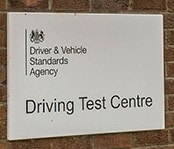Taking a driving test can be nerve wracking. Here are my top 10 driving test tips to (hopefully) make it a bit easier.
1. Be Prepared
There are lots of failed driving tests due to nerves on the day but most tests are failed because the candidates are not properly enough prepared. Your and your instructor should have a check-list and by the time you get to test, you should be able to do everything on it independently, without your instructor’s help. If your instructor is still needing to tell you to remember to change into first gear when you stop, or needing to prompt you to check mirrors before changing lanes, or in fact pretty much anything else, then you are not ready to take your test! The driving test is a test of your ability to drive, in varying road and traffic conditions, by yourself, without you needing anyone to tell you what to do. You should be making your own decisions and not relying on your instructor to make them for you.
Also, make sure you thoroughly know all your Show Me Tell Me answers. Getting one of these wrong at the beginning of your test does not promote confidence.
2. Know Your Area
Whilst I am not a fan of learning test routes, there are (certainly in York, anyway) particular junctions and roundabouts et cetera that may be in some way unusual to the point of being a bit tricky. See my features blogs. There are those that would argue if you can drive properly, then you can drive properly anywhere. I wouldn’t necessarily disagree but my trainee instructors are often caught out the first time they arrive at one of my “features”. And these trainee instructors have often been driving for several years. Being familiar with your area and with the tricky stuff you might find on a test stacks the cards in your favour. Who wouldn’t want to have that edge?
3. You Start With A Clean Sheet
When you meet the examiner, you start the test with a clean sheet. In a way, you’ve already passed. You’ve just got to keep it that way for the next 40 minutes.
4. Focus
From the moment you get into the car, you need to focus entirely on your driving. Think about nothing else. If you catch your mind wandering, bring it back to your driving. Look well ahead and give yourself time to respond to any hazards. If you’re not sure what’s happening ahead, slow down and don’t get involved until you are.
And one of my favourites – “If in doubt, chicken out!”
5. Drive Your Own Drive
Drive for yourself. Do what you think is right. If’ you’ve been taught well and are properly prepared, you’ll be fine. On no account should you be worrying about what the examiner may be thinking. Because frankly, you have no way of knowing. As soon as you start worrying “would the examiner want me to do this?” you’re more likely to make mistakes as the question will prolong your thinking process and delay decisions you may need to make now! Do what YOU think you should be doing.
6. Keep Calm And Carry On
The sixth of my driving test tips is if you do make a mistake, don’t worry about it. Put it behind you and carry on. Assume it’s just a driving fault (minor fault) and you haven’t failed yet. I vividly remember watching someone fail because they thought they’d failed doing a reversing manoeuvre and they just gave up. In fact at that point, whilst the reversing manoeuvre wasn’t great, they still had a pass in the bag and threw away their test needlessly.
7. Use Your Routines
Prepare, Observe, Move.
Mirror, Signal, Position, Speed, Look.
All the routines and procedures you’ve been taught to use are there to help and structure your driving. Use these routines. They work.
8. Step Up To Your Manoeuvre
You’ve probably been taught your manoeuvres in a series of steps. For example when reversing after pulling up on the right,
- Observe all around and move slowly
- Check your proximity to the kerb
- Do a small adjustment if necessary
- Repeat from number 1.
If these steps worked when you were practising with your instructor then they’ll work on test (and in real life driving) too. The only thing changed is the person sitting next to you. Before you start the manoeuvre, take a moment to gather your thoughts. Rushing in without thinking first probably isn’t going to result in the standard you’re looking for. The steps work. Follow the steps.
9. Don’t Drive EXTRA Carefully
Believe it or not, I’ve sat in the back of a car and watched someone fail for driving too slowly. Painfully slowly, as the examiner put it in the debrief. He’d never driven like this in his lessons so why now? Discussing it on the way home, he told me he was driving especially carefully to show the examiner how safe he was. What this actually resulted in was a long queue of traffic behind us and a failed test for not making sufficient progress. You (hopefully) haven’t been taught to drive wrong by your instructor. You don’t need to go extra slow on your test. The examiner needs to see that you can, where appropriate, make appropriate progress so that you are not needlessly in the way of other road users behind you. Drive like you’ve been taught to drive.
10. Enjoy Yourself
Hopefully you enjoy driving. Certainly most of my clients do so why shouldn’t you enjoy your test too? It’s just driving. If you’re properly prepared,, know your area, keep your focus, and drive your own drive, you shouldn’t have anything to worry about. So use my top 10 driving test tips and enjoy yourself for those 38 to 40 minutes.
